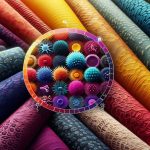You might not realize it, but the fabric of your clothes and bedding plays a significant role in your overall wellness and comfort. Choosing materials with breathability and moisture-wicking properties can greatly enhance your daily comfort and even your emotional well-being. Natural fibers like cotton, linen, and bamboo are often touted for their superior comfort, while innovative fabrics with antimicrobial properties promote a healthier living environment. Understanding these nuances can make a substantial difference in your quality of life, so let's explore how different fabrics contribute to your wellness and comfort.
Table of Contents
Key Takeaways
- Natural fibers like cotton and linen enhance comfort by promoting breathability and moisture absorption.
- Fabrics with antimicrobial properties maintain freshness and reduce the risk of infections and allergies.
- Advanced temperature-regulating textiles adapt to varying climates, ensuring optimal comfort.
- Moisture-wicking materials keep skin dry during physical activities, improving performance and comfort.
- Bamboo fabric offers sustainable, hypoallergenic benefits, ideal for sensitive skin and environmental responsibility.
Importance of Fabric Choice
Choosing the right fabric is pivotal for your overall comfort and well-being. When you're selecting fabrics, you're not just picking a material; you're making a choice that directly impacts your comfort levels throughout the day. The fabric you choose can affect how your skin feels, how your body breathes, and even how you move.
Understanding the significance of fabric selection enables you to tailor your wardrobe and home textiles to suit your specific needs. For instance, if you have sensitive skin, you'll want to avoid fabrics that might cause irritation. Instead, opt for materials known for their softness and hypoallergenic properties. On the other hand, if you live in a hot climate, breathable fabrics become vital for maintaining comfort and preventing overheating.
Moreover, the quality and type of fabric can influence your psychological state. High-quality materials often provide a sense of luxury and confidence, enhancing your overall mood.
Making informed choices in fabric selection allows you to cultivate an environment that promotes both physical and emotional well-being. So, don't underestimate the power of fabric choice; it's a key element in achieving mastery over your comfort levels.
Natural Fibers for Comfort
When you choose natural fibers, you'll appreciate their breathability and how they promote air flow, keeping you cool.
These fabrics also excel in moisture absorption, ensuring you stay dry and comfortable.
Consider how materials like cotton and linen can enhance your well-being.
Breathability and Air Flow
Natural fibers like cotton, linen, and wool excel in breathability, providing superior comfort by allowing air to circulate freely.
When you prioritize fabric breathability, you make sure that your body stays cool and comfortable, especially in warmer climates. These natural fibers promote ideal air flow, which is crucial for preventing overheating and maintaining a pleasant body temperature.
Choosing fabrics with high breathability isn't just about comfort; it's about enhancing your overall well-being. Cotton, for instance, is a go-to fabric because it's lightweight and allows air to move through easily, making it perfect for daily wear.
Linen offers a similar benefit, with its loose weave structure ensuring maximum air circulation. Wool, often thought of as a winter fabric, is surprisingly breathable and can regulate temperature effectively, keeping you cool in summer and warm in winter.
Moisture Absorption Properties
Cotton, linen, and wool stand out for their excellent moisture absorption properties, ensuring you stay dry and comfortable. These natural fibers excel in wicking away sweat from your skin, making them ideal choices for a variety of climates and activities.
Cotton, for instance, can absorb up to 27 times its weight in water, highlighting its superior fiber performance. Similarly, linen's hollow fibers facilitate rapid moisture uptake and evaporation, keeping you cool and collected even in hot weather. Wool, with its natural crimp, traps air and moisture, offering both warmth and dryness.
Fabric testing plays a pivotal role in quantifying these properties, ensuring you get the best performance from your chosen materials. Rigorous assessments under controlled conditions measure absorption rates, wicking speed, and overall comfort. These tests reveal that natural fibers consistently outperform synthetics in moisture management, reinforcing their suitability for high-performance wear.
Benefits of Cotton
You'll quickly notice the advantages of cotton for both comfort and health. Cotton's inherent softness and durability make it an excellent fabric for everyday wear. You'll appreciate how it feels against your skin, providing a gentle touch while standing up to repeated use. Additionally, cotton's allergen resistance guarantees that it's a suitable choice if you have sensitive skin or suffer from allergies.
Cotton's versatility is another reason it stands out. Whether it's casual attire, bedding, or workout gear, cotton adapts effortlessly to various needs. Its breathability keeps you cool in summer and warm in winter, making it a reliable fabric year-round. Also, cotton is easy to care for, maintaining its quality wash after wash, which saves you time and effort.
Here's a quick comparison to summarize cotton's benefits:
| Benefit | Description |
|---|---|
| Softness | Gentle on skin, providing unparalleled comfort |
| Durability | Long-lasting, withstands frequent use |
| Allergen Resistance | Hypoallergenic, ideal for sensitive skin |
| Versatility | Suitable for diverse applications |
Linen's Unique Qualities
While cotton offers numerous benefits, linen brings its own unique set of qualities to the table. You'll immediately notice linen's natural luster and strength, making it a standout choice for those who seek both aesthetics and durability.
One of the key linen benefits is its breathability. Linen fibers allow air to circulate freely, keeping you cool in summer and warm in winter, enhancing your overall comfort.
In terms of sustainability, linen is a top performer. It's derived from the flax plant, which requires less water and fewer pesticides compared to cotton. This eco-friendly aspect makes linen a smart choice for those who prioritize sustainability. Moreover, linen is biodegradable, reducing its environmental footprint.
Now, let's talk about linen care and maintenance. You might think linen's luxurious feel requires demanding upkeep, but it's surprisingly low-maintenance. It becomes softer and more absorbent with each wash, and it's naturally resistant to dirt and stains.
To keep your linen in top shape, wash it in lukewarm water and avoid harsh detergents. Although it may wrinkle easily, embracing its natural, relaxed look adds to its charm.
Bamboo's Advantages
Bamboo fabric offers a unique blend of softness, sustainability, and versatility that makes it a compelling choice for wellness and comfort. You'll find that its sustainability benefits are remarkable, as bamboo grows rapidly without the need for pesticides or excessive water. Its eco-friendly properties guarantee that you're making a responsible choice for the environment.
When it comes to softness and durability, bamboo fabric excels. You'll enjoy a luxurious feel that rivals even the finest cotton, but with the added advantage of lasting longer. This makes bamboo ideal for items you use frequently, like bedding and clothing.
Moreover, bamboo fabric's hypoallergenic features make it perfect for sensitive skin. You won't have to worry about irritations or allergies, ensuring a comfortable experience.
Here's a quick look at how bamboo fabric stands out:
| Feature | Bamboo Fabric |
|---|---|
| Growth Rate | Rapid |
| Pesticides Needed | None |
| Water Usage | Minimal |
| Skin Sensitivity | Hypoallergenic |
| Feel and Longevity | Softness and durability combined |
Innovative Fabric Technologies
You'll be amazed at how innovative fabric technologies can elevate your comfort.
Imagine fabrics that wick away moisture, regulate your body temperature, and integrate antimicrobial properties.
These advancements are redefining how we experience clothing and textiles in our daily lives.
Moisture-Wicking Capabilities Enhanced
Innovative fabric technologies have greatly enhanced moisture-wicking capabilities, keeping you dry and comfortable during any activity. Whether you're pushing your limits in athletic performance or simply enjoying outdoor activities, advanced fabrics are designed to manage sweat efficiently. These fabrics pull moisture away from your skin to the surface, where it can evaporate quickly. This sweat management is essential for maintaining comfort and preventing chafing, ensuring you stay focused on your goals.
For those who thrive on outdoor adventures, staying dry is imperative. Modern fabrics excel in ensuring that even during intense physical exertion, you won't be bogged down by damp clothing. They create a barrier that allows perspiration to escape while blocking external moisture, such as rain or humidity, from penetrating. This dual-action approach keeps you feeling fresh and ready to tackle whatever challenges come your way.
When it comes to athletic performance, these innovations can make a significant difference. By keeping your body dry, these fabrics help regulate your body's natural cooling process, allowing you to maintain peak performance levels for longer durations. Embrace the benefits of these cutting-edge fabrics and elevate your wellness and comfort to new heights.
Temperature Regulation Advancements
Temperature-regulating textiles are revolutionizing how we stay comfortable in varying climates by adapting to our body's needs. Imagine wearing a garment that knows when you're too hot or too cold and adjusts accordingly. These intelligent fabrics leverage high tech solutions to provide unparalleled climate control, ensuring you remain at the ideal temperature regardless of external conditions.
Recent fabric advancements have introduced materials embedded with phase change materials (PCMs) that absorb, store, and release heat as necessary. When your body temperature rises, these PCMs absorb excess heat, cooling you down. Conversely, when you start to get chilly, the stored heat is released to keep you warm. This dynamic response is a game-changer, especially for athletes and outdoor enthusiasts who frequently face varying temperatures.
Additionally, some innovative fabrics incorporate microcapsules filled with cooling agents that activate upon contact with sweat, providing immediate relief. These high tech solutions aren't just confined to athletic wear; they're making their way into everyday clothing and even bedding, enhancing overall comfort and well-being.
Antimicrobial Properties Integration
Incorporating antimicrobial properties into fabrics is revolutionizing hygiene and health in everyday wear. You'll find that antimicrobial technology in textiles helps combat bacteria, fungi, and other harmful microbes that can compromise fabric hygiene.
By integrating these properties, your clothing, bedding, and even upholstery stay fresher for longer, reducing the need for frequent laundering and extending the lifespan of your items.
Here's how you can benefit from antimicrobial fabrics:
- Enhanced Health Protection: Reduced exposure to harmful microbes means fewer chances of infections and allergies.
- Odor Control: These fabrics inhibit the growth of odor-causing bacteria, keeping you feeling fresh throughout the day.
- Longevity and Maintenance: Antimicrobial textiles require less frequent washing and maintain their quality over time.
With the rise of innovative fabric technologies, you're no longer reliant on just the material's natural properties. Advanced treatments and coatings provide an extra layer of protection, ensuring superior fabric hygiene.
Investing in these fabrics means you're prioritizing health, comfort, and convenience. As the industry evolves, staying informed about these advancements will empower you to make choices that contribute to a healthier lifestyle.
Moisture-Wicking Materials
Moisture-absorbing materials are designed to keep you dry by drawing sweat away from your skin. This feature is essential for anyone serious about athletic performance. When you're pushing your limits, the last thing you need is to be distracted by damp, clingy clothing. Instead, moisture-absorbing fabrics guarantee enhanced comfort, allowing you to focus entirely on your workout.
For outdoor activities, these materials are a game-changer. Whether you're hiking, running, or cycling, effective sweat management can make or break your experience. Imagine scaling a mountain or cycling through challenging terrain; moisture-absorbing fabrics help regulate your body temperature, keeping you cool and dry. They work by pulling moisture to the fabric's surface, where it can evaporate more easily.
You might wonder how these fabrics achieve such efficiency. Generally, they're crafted from synthetic fibers like polyester or nylon, which have inherent moisture-absorbing properties. Some advanced versions even blend these synthetics with natural fibers, offering the best of both worlds.
Antimicrobial Properties
Antimicrobial fabrics stand out because they actively combat bacteria and odors, maximizing your clothing's freshness even after intense workouts. These fabrics incorporate advanced fabric technology designed to offer effective odor control and significant health benefits. By integrating antimicrobial properties, these fabrics prevent the growth of harmful bacteria, fungi, and other microbes that can cause unpleasant smells and potential skin infections.
Here are three key benefits of using antimicrobial fabrics:
- Odor Control: Antimicrobial fabrics reduce bacteria buildup, which is often the primary cause of body odor. This means you can enjoy confidence and freshness throughout your day, regardless of your activity level.
- Health Benefits: By minimizing bacterial and fungal growth, these fabrics help protect your skin from potential infections and irritations, promoting overall skin health.
- Long-lasting Freshness: The advanced fabric technology used in antimicrobial treatments ensures that your garments remain fresh and hygienic for longer periods, reducing the need for frequent washing and enhancing the lifespan of your clothing.
Embracing antimicrobial fabrics not only offers practical advantages but also contributes to your overall well-being. These innovative textiles are a game-changer for anyone seeking to maintain peak hygiene and comfort in their daily wardrobe.
Temperature Regulation
Temperature-regulating fabrics keep you comfortable by maintaining an ideal body temperature, whether you're active or at rest. With advanced cooling technology, these fabrics wick moisture away from your skin, ensuring you stay dry and cool during intense workouts or hot weather. You'll notice the difference on a run or during a yoga session; the fabric works tirelessly to dissipate heat away from your body.
On the flip side, heat retention is equally essential, especially in colder environments. High-performance fabrics designed for cooler climates trap warmth close to your body, creating an insulating layer that prevents heat loss. This dual capability of cooling and heat retention is what sets temperature-regulating fabrics apart, making them indispensable for anyone seeking comfort and wellness in all conditions.
For an ideal experience, look for fabrics with integrated cooling technology and efficient heat retention properties. These fabrics adapt to your body's needs, delivering superior performance whether you're climbing mountains or lounging at home.
Mastering the art of temperature regulation through your choice of fabrics not only enhances comfort but also supports overall well-being, allowing you to focus on what truly matters.
Frequently Asked Questions
How Should Fabrics Be Cared for to Maintain Their Benefits?
To maintain fabric durability and longevity, prioritize proper fabric maintenance. Wash according to care labels, avoid harsh detergents, and store in a cool, dry place. Correct washing and storage routines will preserve your fabrics' benefits.
Are There Eco-Friendly Fabric Options Available?
Yes, you've got eco-friendly fabric options like organic cotton and bamboo fabric. They're sustainable, breathable, and durable. By choosing these, you're not only enhancing comfort but also contributing positively to the environment.
What Are the Best Fabrics for Sensitive Skin?
When choosing fabrics for sensitive skin, you can't go wrong with natural fibers like organic cotton or bamboo. These materials are gentle and moisture-wicking, keeping you comfortable while reducing irritation.
How Can Fabric Choice Impact Athletic Performance?
Selecting the appropriate fabric can have a major impact on your athletic performance. Fabrics with sweat wicking technology and breathability keep you dry, while flexibility and durability guarantee unrestricted movement and long-lasting wear, enhancing your overall workout efficiency.
Do Certain Fabrics Help With Allergies or Asthma?
An ounce of prevention is worth a pound of cure. You can manage allergies and asthma better by choosing hypoallergenic fabrics. The health benefits of using these fabrics include reduced allergens, leading to fewer asthma and allergy flare-ups.
- Tetron Fabric for Marine Applications: Durability and Use Cases - June 18, 2025
- Tetron Fabric for Outdoor Furniture: Weather Resistance and Care - June 18, 2025
- Tetron Fabric for Wall Coverings: Style and Application Tips - June 18, 2025







